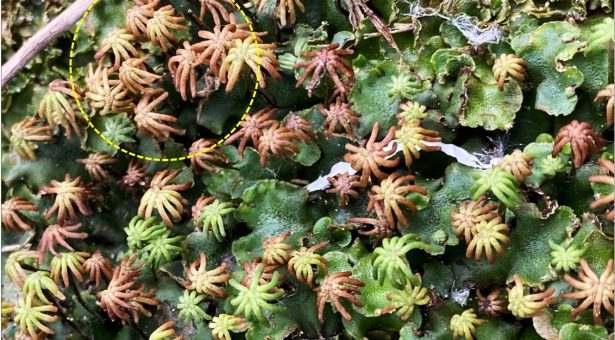
The life of a plant scientist involves long hours in the lab, thinking up, designing, and monitoring experiments that might tell us something new about how life works.
But sometimes it helps to log off the computer, hang up the lab coats, and seek inspiration in nature.
Researchers at the John Innes Centre did just this, heading out into the greener parts of Norwich Research Park where the laboratory of Dr Phil Carella is based.
The object of their search was a humble weed-like non-flowering plant, a type of liverwort called Marchantia polymorpha that typically inhabits cracks in pavements.
"We work with lab-grown versions of these non-flowering species in our experiments, often infecting them with pathogens from flowering plants. Our colleagues are often asking us if they naturally get infected too. So, we devised a little side project to go outside and check it out. Then some interesting things started to happen," said Dr Carella.
The result is a new scientific study in Current Biology that underscores the fundamental nature of how plants get sick and how we might help them avoid infection from parasitic microbes, some of our major crops included.
The Carella group at the John Innes Centre studies plant immunity and pathogen virulence – using diverse and distantly related plants such as Marchantia polymorpha as a scientific model.
These non-flowering plants diverged from their flowering relatives around 500 million years ago and their 'less complex' genomes and growth requirements make them a useful model to explore how the Plant Kingdom is diversely affected by disease spreading pathogens.
Previous research by the Carella group has shown that bacterial pathogens in the Pseudomonas syringae species complex can colonise distantly related plants, both flowering and non-flowering species.
These previous experiments have taken place in the lab but, to answer the question of whether these findings apply in nature, the researchers devised and delivered an innovative series of experiments managed by laboratory technician and first author of the study Kayla Robinson.
First, the team went out into the site to find examples of Marchantia polymorpha that were showing signs of disease. From these sick plants they used microbiology techniques to isolate 40 strains of Pseudomonas bacteria, some pathogenic and some non-pathogenic.
Next, they took some of these bacterial strains and re-infected lab-grown examples of Marchantia polymorpha.
Some of the strains, identified using genetic sequencing technology, were a species called Pseudomonas viridiflava, a known opportunistic pathogen of flowering plants which has never been identified before in non-flowering plants such as liverwort.
Genomic analysis of pathogenic strains revealed five bacterial 'effector' genes, two of which were common amongst all Pseudomonas pathogens and were involved in allowing the pathogenic bacteria to infect the liverwort.
The researchers then repeated these experiments to infect the flowering model plant Nicotiana benthamiana to show that the same core infection machinery was used by this bacterial pathogen to colonise both flowering and non-flowering plants.
"Our study shows that there is a common mechanism for causing disease in very distantly related plants," said Dr Carella. "Some of the bacterial species we work on have up to thirty effectors, but here we have isolated one streamlined pathogen with just five effectors that can infect such different plants.
"We think we have found the minimum complement of effectors needed to infect a plant whether it is flowering or non-flowering. This implies that these effectors are targeting very deeply conserved and potentially ancient immunity processes in plants."
Being able to use Marchantia polymorpha as a model species which is relevant to flowering plants including crops opens the doors in the field of plant immunity, added Dr Carella.
"In addition to the evolutionary insights there are practical benefits of using Marchantia: it is small and easier to grow than flowering plants and is haploid – this means it has one copy of the genome instead of two so it's a faster more streamlined system, and yet one that is relevant for understanding shared aspects of immunity and infection across the Plant Kingdom."
If the study highlights the importance of getting outside to unlock nature's diversity, it also highlights the importance of skilled lab technicians to fundamental discovery science, added Dr Carella.
"The majority of the work was undertaken by our very talented research technician Kayla Robinson. Having someone with the experience and expertise to be able to carefully assess each experiment, plan, and adjust as needed is imperative to the success of our work and is just one of the reasons the John Innes Centre recognises the value of technicians by signing up to the Technician Commitment."
Conserved effectors underpin the virulence of liverwort-isolated Pseudomonas in divergent plants appears in Current Biology.






